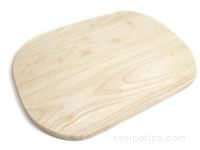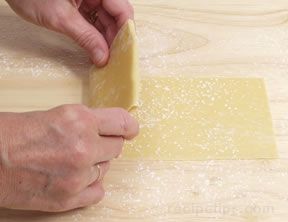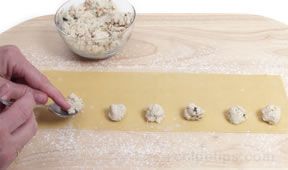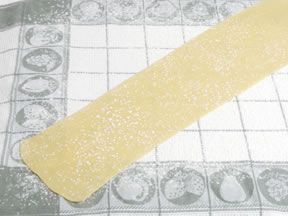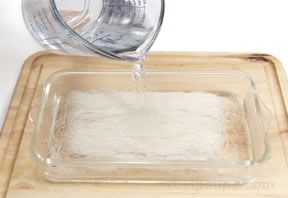|
Pasta is allowed to dry to varying degrees for different purposes. The amount of drying time varies according to the type of pasta, drying conditions and the drying method used. Shown below are some of the drying methods used and their purpose.
|
Drying Before Cutting: The pasta dough should be allowed to dry after it has been rolled out and before cutting it into noodles or shapes. Allowing it to dry for approximately 15 minutes will make the dough less sticky and allow it to cut better whether cutting by machine or by hand. If cutting noodles, do not let the dough dry too much, because it may start to crack while being cut.
If making stuffed pasta, do not allow the dough to dry before cutting and stuffing. This will allow the dough to remain flexible and slightly sticky, which will provide a better seal.
Drying Before Cooking: After fresh pasta noodles and shapes have been cut, they should be placed on a lightly floured surface and allowed to dry for at least 15 minutes before cooking.
|
     |
The drying period allows the pasta to dry enough so that it becomes a little firm and less sticky, which helps prevent the pasta from clumping and sticking together when it is cooked. The shaped pastas also hold their shape better when allowed to dry slightly before cooking.
Drying Before Storage: Fresh pasta can be dried completely and then stored at room temperature. Shaped pasta should be laid out on a floured surface and lightly dusted with flour. The shapes should not be touching each other and they should be turned periodically to allow proper air exposure to all sides. This will allow the shapes to dry evenly.
There are a couple of ways in which pasta noodles can be dried. The noodles can be laid out on a floured surface, lightly dusted with flour, left uncovered and allowed to remain there until they are completely dried. The strands should be separated so they are not touching, allowing proper air exposure. Wide noodles should also be turned over to allow the under side to dry properly. The thin noodles should dry sufficiently without turning.
Pasta noodles can also be hung over the back of a chair on a floured dish towel, over a broom handle, or on a drying rack to dry. Allow the noodles to sit in a warm dry location while drying. Long pasta noodles, such as angel hair, tagliatelle, tagliarini, and fettuccine, are sometimes wrapped into a nest and allowed to dry. |
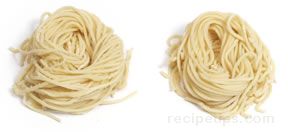 |
 |
|
The nests must be turned over often to aid in drying thoroughly and to prevent it from molding on the bottom side.
The drying time for all fresh pasta will vary greatly. Drying times are affected by the size, shape and thickness of the pasta. The drying method and the temperature and humidity of the area in which it is dried will also greatly affect the drying time. Once the pasta is completely dry, it can be stored in an airtight container, in a cool dry area, at room temperature, for several months. | |










